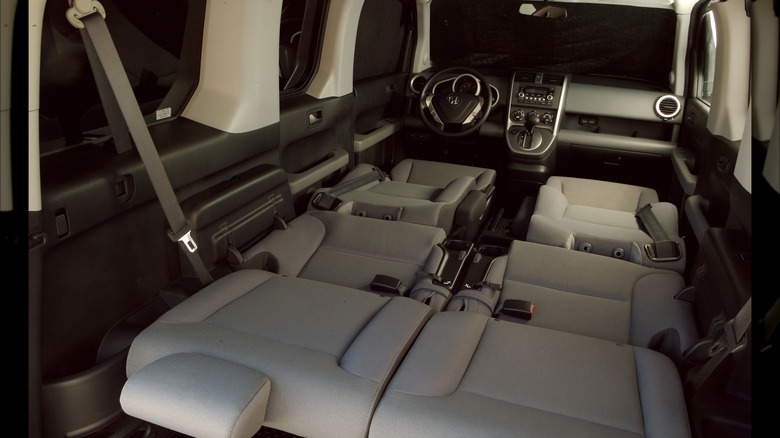Here's Why The Honda Element Was Discontinued
In the late '90s, both the Honda CR-V and Toyota RAV4 gave the world its first glimpse at a crossover and how it was different from an SUV. In 2003, a retro, boxy new model rolled off Honda's production line called the Element. This vehicle's design was very different from existing cars, which is part of why so many people hate the Honda Element to this day. Despite some negative views about it, this vehicle did have a loyal following of fans, but they were unable to prevent it from being discontinued in 2011.
There were a few issues going against the Honda Element that led to its demise. First, the retro-blockish exterior was polarizing, which is unfortunate because the Element did provide some functional features. For example, you can lay all the seats flat, and a lack of pillar structure between the front and rear doors provided an extra-wide opening for loading. Honda also completely misunderstood which demographic would embrace the Element. The automaker marketed the crossover to a younger, active crowd, but it ended up becoming popular with older drivers instead. This issue was compounded by the Element's price, which was simply out of reach for its intended audience.
Outward appearance and assumptions
It wasn't just that buyers were divided on the box-like body of the Honda Element, it was that those initially negative perceptions created assumptions about the car overall. Like the old saying, "Don't judge a book by its cover," the unfortunate crossover didn't get a chance to show drivers its advantages. One expert reviewer on the 2003 Honda Element explained, "A blindfold is not required equipment for road testing a vehicle – for good, and obvious, reasons. However, the use of one may help resolve conflicting premises presented by this test subject."
Contrary to its physical appearance, the Element's 2.4L engine produces 160 horsepower and offers a responsive driving experience and available 4WD. The odd body shape also enabled a significant cargo area of over 70 cubic feet, and even more if you removed the rear seats. There's so much space, in fact, that the 2003 Element beats out the Honda CR-V from the same year in terms of front and back headroom, and legroom.
Young people couldn't afford it, and older drivers loved it
Originally, the Honda Element was supposed to cater to the early twenty-something group, that would pack the crossover with surfboards, snowboards, and other outdoor sports equipment. Honda even held a college marketing championship for the Element in 2003, that included nearly 30 institutions taking part. The automaker described its vehicle as "designed to fit the needs of a new generation of car buyers." But the starting retail price of $18,760 was too much. While this might sound like a bargain today, when adjusted for inflation, that would be the equivalent of over $32,000 today. Honda may have been trying to appeal to the younger generations, but many of them just couldn't afford it.
However, the Element did take off with older drivers who weren't necessarily interested in outdoor sports, but valued the vehicle's functionality. One report found that the average age of a Honda Element owner was 43, per Forbes. The push from Honda to attract young drivers also likely suffered as older motorists and parents started driving the Element around. What young person wants to drive around the same vehicle as their parents? The unique crossover saw declining sales from 2005 on to its last year of production in 2011, where Honda only sold 11,534 units, per Good Car Bad Car. On the plus side, the 2011 Element is considered one of the most reliable and cheap Hondas to buy used.


